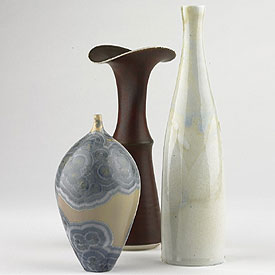2005 The Egner Donation
21. October 2005 to 22. February 2006
Ceramic Vessels from the Egner Donation
Cabinet Exhibition
Shaping and firing clay is one the oldest techniques used by mankind in order to create objects. For centuries ceramics have been used to fulfil daily and ritual needs. Due to the nature of the material as well as its basic functionality, ceramic vessels, which can be found in all cultures and all epochs, are linked typologically. Ceramic art in particular allows ancient and modern works to be exhibited naturally side by side and have a contemporary look. Because the exploration of existential questions as revealed through art lies at the heart of Kolumba's philosophy, ceramic art is an important medium. Adolf Egner, born in 1932 in Worms, has since 1970 acquired one of the largest private collections of contemporary ceramics through purchases from galleries and art fairs but primarily from artists' studios. Although initially used for flower arranging, the objects soon themselves became the focus of Egner's collection, the striking feature of which is its diversity and multi-facetedness. In recent years Egner has parted with a large part of his collection by giving three museums the opportunity to select works according to their own criteria. We were able to select 266 works for Kolumba – vases, bowls, jugs, mugs, cups and pots – which as single works as well as sets demonstrate the variety of ceramic vessels, glazes and techniques. Alongside the works of German ceramic artists the collection encompasses examples from the Netherlands, France and Austria from the late 1950s onwards as well as ceramics from Great Britain, which Egner knows particularly well. We would like to extend a warm thank you to the benefactor with the first exhibition of a selection of the gifted works.
Ceramic Vessels from the Egner Donation
Cabinet Exhibition
Shaping and firing clay is one the oldest techniques used by mankind in order to create objects. For centuries ceramics have been used to fulfil daily and ritual needs. Due to the nature of the material as well as its basic functionality, ceramic vessels, which can be found in all cultures and all epochs, are linked typologically. Ceramic art in particular allows ancient and modern works to be exhibited naturally side by side and have a contemporary look. Because the exploration of existential questions as revealed through art lies at the heart of Kolumba's philosophy, ceramic art is an important medium. Adolf Egner, born in 1932 in Worms, has since 1970 acquired one of the largest private collections of contemporary ceramics through purchases from galleries and art fairs but primarily from artists' studios. Although initially used for flower arranging, the objects soon themselves became the focus of Egner's collection, the striking feature of which is its diversity and multi-facetedness. In recent years Egner has parted with a large part of his collection by giving three museums the opportunity to select works according to their own criteria. We were able to select 266 works for Kolumba – vases, bowls, jugs, mugs, cups and pots – which as single works as well as sets demonstrate the variety of ceramic vessels, glazes and techniques. Alongside the works of German ceramic artists the collection encompasses examples from the Netherlands, France and Austria from the late 1950s onwards as well as ceramics from Great Britain, which Egner knows particularly well. We would like to extend a warm thank you to the benefactor with the first exhibition of a selection of the gifted works.

